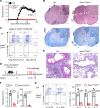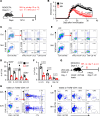Apex1 safeguards genomic stability to ensure a cytopathic T cell fate in autoimmune disease models
- PMID: 39739423
- PMCID: PMC11827838
- DOI: 10.1172/JCI183671
Apex1 safeguards genomic stability to ensure a cytopathic T cell fate in autoimmune disease models
Abstract
T cells have a remarkable capacity to clonally expand, a process that is intricately linked to their effector activities. As vigorously proliferating T cell also incur substantial DNA lesions, how the dividing T cells safeguard their genomic integrity to allow the generation of T effector cells remains largely unknown. Here we report the identification of the apurinic/apyrimidinic endonuclease-1 (Apex1) as an indispensable molecule for the induction of cytopathic T effectors in mouse models. We demonstrate that conditional deletion of Apex1 in T cells resulted in a remarkable accumulation of baseless DNA sites in the genome of proliferating T cells, which further led to genomic instability and apoptotic cell death. Consequently, Apex1-deleted T cells failed to acquire any effector features after activation and failed to mediate autoimmune diseases and allergic tissue damages. Detailed mutational analyses pinpointed the importance of its endonuclease domain in the generation of T effector cells. We provide further evidence that inhibiting the base repair activities of Apex1 with chemical inhibitors similarly abrogated the induction of autoimmune diseases. Collectively, our study suggests that Apex1 serves as a gatekeeper for the generation of cytopathic T cells and that therapeutically targeting Apex1 may have important clinical implications in the treatment of autoimmune diseases.
Keywords: Autoimmune diseases; Autoimmunity; Immunology; T cells.
Figures






Similar articles
-
S-adenosylmethionine regulates apurinic/apyrimidinic endonuclease 1 stability: implication in hepatocarcinogenesis.Gastroenterology. 2009 Mar;136(3):1025-36. doi: 10.1053/j.gastro.2008.09.026. Epub 2008 Sep 25. Gastroenterology. 2009. PMID: 18983843 Free PMC article.
-
APEX1 in intestinal epithelium triggers neutrophil infiltration and intestinal barrier damage in ulcerative colitis.Free Radic Biol Med. 2024 Nov 20;225:359-373. doi: 10.1016/j.freeradbiomed.2024.10.260. Epub 2024 Oct 9. Free Radic Biol Med. 2024. PMID: 39389211
-
From DNA Repair to Redox Signaling: The Multifaceted Role of APEX1 (Apurinic/Apyrimidinic Endonuclease 1) in Cardiovascular Health and Disease.Int J Mol Sci. 2025 Mar 26;26(7):3034. doi: 10.3390/ijms26073034. Int J Mol Sci. 2025. PMID: 40243693 Free PMC article. Review.
-
Mild phenotype of knockouts of the major apurinic/apyrimidinic endonuclease APEX1 in a non-cancer human cell line.PLoS One. 2021 Sep 16;16(9):e0257473. doi: 10.1371/journal.pone.0257473. eCollection 2021. PLoS One. 2021. PMID: 34529719 Free PMC article.
-
Apurinic/Apyrimidinic Endonuclease 2 (APE2): An ancillary enzyme for contextual base excision repair mechanisms to preserve genome stability.Biochimie. 2021 Nov;190:70-90. doi: 10.1016/j.biochi.2021.07.006. Epub 2021 Jul 21. Biochimie. 2021. PMID: 34302888 Review.
Cited by
-
Potential of platelet-rich plasma-derived exosomes for bone-defect repair: in vitro and in vivo study.Hum Cell. 2025 Jun 10;38(4):117. doi: 10.1007/s13577-025-01244-5. Hum Cell. 2025. PMID: 40493272
-
68Ga-MY6349 PET/CT-guided TROP2-targeted therapy in mCRPC.Eur J Nucl Med Mol Imaging. 2025 Aug 27. doi: 10.1007/s00259-025-07501-x. Online ahead of print. Eur J Nucl Med Mol Imaging. 2025. PMID: 40864221 No abstract available.
-
Addressing graft-versus-host disease in allogeneic cell-based immunotherapy for cancer.Exp Hematol Oncol. 2025 May 2;14(1):66. doi: 10.1186/s40164-025-00654-3. Exp Hematol Oncol. 2025. PMID: 40317083 Free PMC article. Review.
-
Exploring the potential relationships between idiopathic scoliosis and various multifactorial diseases: a systematic scoping review.Spine Deform. 2025 Jul;13(4):1019-1026. doi: 10.1007/s43390-025-01085-0. Epub 2025 Apr 9. Spine Deform. 2025. PMID: 40202707
-
Beyond T-cell subsets: stemness and adaptation redefining immunity and immunotherapy.Cell Mol Immunol. 2025 Sep;22(9):957-974. doi: 10.1038/s41423-025-01321-7. Epub 2025 Jul 10. Cell Mol Immunol. 2025. PMID: 40634636 Free PMC article. Review.
References
MeSH terms
Substances
Grants and funding
LinkOut - more resources
Full Text Sources
Medical
Molecular Biology Databases
Research Materials
Miscellaneous

